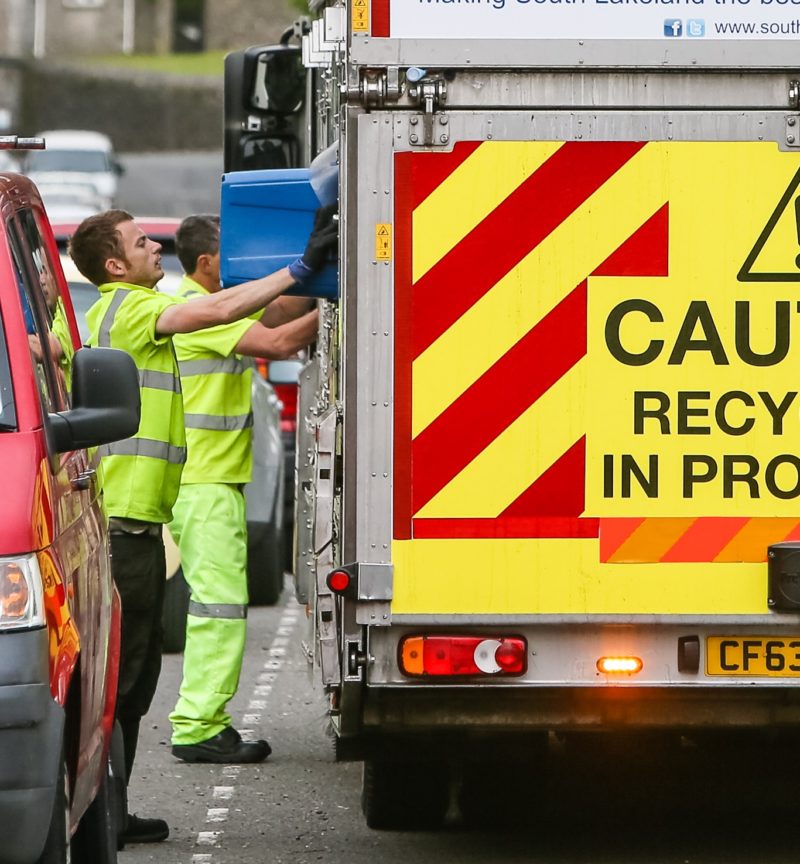Containers and vehicles can be redesigned to reduce the manual handling risks from kerbside recycling collections, a new report from the government’s Health and Safety Executive (HSE) has suggested.
The document highlighted the importance of vehicles having low load-heights, as well as the need for better handles on both recycling containers and sacks.

Refuse crew injury risk was assessed as part of the HSE study
Manual handling is related to 35% of the injuries leading to absences from work of more than seven days that are reported to HSE, say the report’s authors Dr Andrew Pinder and Dr Olanrewaju Okunribido. They claim the industry could still do more to reduce the risk of muscular-skeletal injuries.
HSE suggested that government targets to reduce landfill could impact manual handling risks for waste collectors.
It said: “Government targets for reducing waste going to landfill have led to an increase in the processing of domestic waste to reclaim recyclable materials.
“Manual sorting tasks can occur at the kerbside during waste collection and, if poorly designed, can introduce manual handling risks.”
Vehicles
HSE noted that the loading heights of vehicles varied widely – some were at a good level, whilst others were too high.
The report also encourages vehicle manufacturers to develop a system which would allow boxes to be hung from the flaps of vehicle compartments that contain lifting mechanisms, in order to discourage loaders from pressing boxes against the vehicle using their thighs or torsos.
Recycling containers
HSE makes clear that the industry is already using smaller containers as an effective way to reduce the weights being handled of heavy materials such as glass.
‘Slave bins’ and stacking boxes were both identified as safer options for waste collection and recorded low MAC (manual handling assessment) scores.
Better handles and grab rings on recycling containers are recommended – on boxes poor grab rings increase the pressure put through the worker’s fingertips and sacks or bags without handles can force the loader to lift the load above head height when putting it into the vehicle, HSE said.
Food caddies are noted by the report as an area that needs improvement also. It is suggested that they could be incorporated into a trolley to remove the need to carry them and that the handles could be redesigned to improve grip and encourage the use of both hands.
Tenders
The HSE also advises that there should be specific references within tenders to the need to reduce health and safety risks, particularly from manual handling. It also recommends that employees’ psychological responses to their work are considered, from the performance of individual tasks to the broader culture of the workplace.
Though encouraging the waste industry to make changes to kerbside recycling processes, HSE acknowledged that there would be challenges.
A statement said: “Unsurprisingly, the lowest risk tasks identified by the research involved low loading heights and wheeled containers but this does not mean that HSE are proposing a ‘one type fits all’ approach to collection and recognises the need for a holistically designed waste collection system, taking into account the environment, locality and other risks.”
The rate of worker injuries reported to HSE in the waste and recycling sector is significantly higher than that across other industries.
As well as assessing previous reports on kerbside recycling and manual handling, staff from the HSE’s science division observed a range of kerbside collection systems, including source separation by residents, sorting at the kerbside by collection teams and the collection of co-mingled materials for sorting at an MRF.
The post HSE lays out steps to reduce manual handling risks appeared first on letsrecycle.com.
Source: letsrecycle.com Waste Managment


